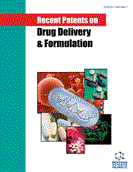Abstract
Atopic dermatitis is a chronic inflammatory disease of the skin, which is characterized by itching, erythema, and eczematous lacerations. It affects about 10 % of adults and approximately 15-20 % of children worldwide. As a result of genetic, immunologic, and environmental factors, the disease manifests itself with the impaired stratum corneum barrier and then immunological responses. Topical administration of corticosteroids and calcineurin inhibitors are currently used as the first strategy in the management of the disease. However, they have low skin bioavailability and some side effects. The nanocarriers as novel drug delivery systems could overcome limitations of conventional dosage forms, owing to increment of poorly soluble drug' solubility, then its thermodynamic activity and, consequently, its skin permeation. Also, side effects of the drug substances on the skin could be reduced by the nano-sized drug delivery systems due to encapsulation of the drug in the nanocarriers and targeted drug delivery of drug substances to the inflammated skin areas. Thereby, there have been available numerous research studies and patents regarding the use of nanocarriers in the management of atopic dermatitis. This review focuses on the mechanism of disease and development of nanocarrier based on novel drug release systems in the management of atopic dermatitis.
Keywords: Atopic dermatitis, calcineurin inhibitors, corticosteroids, skin permeation, tacrolimus, nanocarriers.
[http://dx.doi.org/10.3390/ijms20225659]
[http://dx.doi.org/10.5114/ada.2018.75234]
[http://dx.doi.org/10.1016/S0140-6736(15)00149-X]
[http://dx.doi.org/10.1056/NEJMra074081]
[http://dx.doi.org/10.4103/2229-5178.142483]
[http://dx.doi.org/10.1016/j.ijpharm.2003.07.013]
[http://dx.doi.org/10.1007/s40257-013-0020-1]
[http://dx.doi.org/10.1007/978-3-319-46248-63]
[http://dx.doi.org/10.1002/app.42883]
[http://dx.doi.org/10.7508/ibj.2016.01.001]
[http://dx.doi.org/10.3109/10717544.2014.960981]
[http://dx.doi.org/10.2147/IJN.S150319]
[http://dx.doi.org/10.1016/j.ijpharm.2018.08.053]
[http://dx.doi.org/10.2174/1567201814666170918163615]
[http://dx.doi.org/10.1111/imm.13152]
[http://dx.doi.org/10.5599/obp.8.15]
[http://dx.doi.org/10.1038/jid.2011.119]
[http://dx.doi.org/10.1684/ejd.2019.3557]
[http://dx.doi.org/10.1101/cshperspect.a000414]
[http://dx.doi.org/10.1016/j.jim.2013.08.004]
[http://dx.doi.org/10.1016/j.immuni.2007.08.012]
[http://dx.doi.org/10.1016/j.cell.2006.02.015]
[http://dx.doi.org/10.1097/ACI.0b013e328364ddfd]
[http://dx.doi.org/10.1111/j.1399-3038.2008.00764.x]
[http://dx.doi.org/10.1016/j.jaad.2017.12.024]
[http://dx.doi.org/10.1159/000358606]
[http://dx.doi.org/10.5114/ada.2018.73159]
[http://dx.doi.org/10.1111/j.1600-065X.2011.01027.x]
[http://dx.doi.org/10.1111/j.1398-9995.2006.01153.x]
[http://dx.doi.org/10.1016/S0065-2776(09)01203-6]
[http://dx.doi.org/10.1016/j.jaci.2012.02.002]
[http://dx.doi.org/10.1007/s00109-005-0672-2]
[http://dx.doi.org/10.1016/j.jaci.2006.03.037]
[http://dx.doi.org/10.1111/j.1398-9995.2009.02255.x]
[http://dx.doi.org/10.1111/bjd.12975]
[http://dx.doi.org/10.1016/j.bioactmat.2019.11.003]
[http://dx.doi.org/10.1016/j.bfopcu.2016.12.003]
[http://dx.doi.org/10.5114/pdia.2014.40962]
[http://dx.doi.org/10.1007/s40272-013-0013-9]
[http://dx.doi.org/10.1111/jdv.16219]
[http://dx.doi.org/10.1016/j.colsurfb.2016.08.027]
[http://dx.doi.org/10.3390/cosmetics6030052]
[http://dx.doi.org/10.1159/000445776]
[http://dx.doi.org/10.1016/j.ejpb.2018.02.037]
[http://dx.doi.org/10.1002/jps.23446]
[http://dx.doi.org/10.1016/j.ijpharm.2013.01.024]
[http://dx.doi.org/10.1371/journal.pone.0113143]
[http://dx.doi.org/10.2147/IJN.S71543]
[http://dx.doi.org/10.1016/j.carbpol.2016.03.068]
[http://dx.doi.org/10.1016/j.ijpharm.2016.05.005]
[http://dx.doi.org/10.1002/jps.24666]
[http://dx.doi.org/10.1007/s13346-017-0439-7]
[http://dx.doi.org/10.1007/s13346-018-0480-1]
[http://dx.doi.org/10.1080/03639045.2018.1542704]
[http://dx.doi.org/10.1021/mp400639e]
[http://dx.doi.org/10.4155/tde-2017-0075]
[http://dx.doi.org/10.1016/j.ijpharm.2012.04.051]
[http://dx.doi.org/10.1166/jbn.2011.1191]
[http://dx.doi.org/10.1016/j.ejpb.2011.02.016]
[http://dx.doi.org/10.1016/j.ejpb.2012.11.026]
[http://dx.doi.org/10.1016/j.ijpharm.2019.118624]
[http://dx.doi.org/10.2147/IJN.S215153]
[http://dx.doi.org/10.1016/j.carbpol.2018.06.023]
[http://dx.doi.org/10.1016/j.ejpb.2019.03.006]
[http://dx.doi.org/10.3390/pharmaceutics11080394]
[http://dx.doi.org/10.1016/j.ajps.2013.09.005]
[http://dx.doi.org/10.1016/j.ejpb.2012.05.011]
[http://dx.doi.org/10.1100/2012/874053]
[http://dx.doi.org/10.1208/s12249-013-0017-3]
[http://dx.doi.org/10.3109/08982104.2014.899365]
[http://dx.doi.org/10.1016/j.apmt.2020.100593]
[http://dx.doi.org/10.1016/j.ijpharm.2019.118918]
[http://dx.doi.org/10.1016/j.nano.2019.102140]
 76
76 3
3 1
1 1
1
















